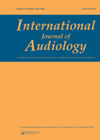
Journal Reviews
Internet-based aural rehabilitation (IAR)
Rapid information technology development allows use of the internet in several areas. It is therefore not surprising that online rehabilitation programmes attract a large interest of researchers worldwide. This study aimed to analyse what participants’ experiences of IAR are. The...
Speech perception in the ageing population
Speech perception can present a challenge as we grow older. One of the factors responsible is, of course, hearing loss. Now research indicates that other non-auditory factors like cognitive decline may also contribute to difficulties in understanding speech. The authors...
Management of patients with advanced otosclerosis
This paper discusses the management options of advanced otosclerosis. There are several definitions for advanced otosclerosis in the literature but, more recently, the diagnosis of advanced otoscletosis has been reserved for patients who have less than 30% aided speech discrimination...
Treating middle ear conditions in developing countries
This month’s journal issue discussed global health in otolaryngology with this paper focusing on the management of chronic middle ear disease in the developing world. Chronic suppurative otitis media (CSOM) is more common in developing countries. The reason for this...
Attitudes towards leisure noise
Noise is a very common reason for hearing loss. The question is whether young adults realise the danger of developing a noise related hearing loss. The aim of this study was to evaluate the attitude towards leisure noise and noise...
Does stress and anxiety worsen idiopathic sudden hearing loss outcomes?
There have been suggestions that the natural course of the idiopathic sudden sensorineural hearing loss (ISSNHL) is not affected by intensive therapy. There is speculation as to whether unknown factors affect the treatment prognosis. This is a retrospective study of...
Hearing loss and QOL
This article evaluates the impact of hearing loss and its rehabilitation on the quality of life (QoL) of adults. The authors suggest that the currently used scale, Aphab, is long, complicated and does not take into account minor changes. The...
Milestones profile for children with cochlear implant
Over the last eight years, Nottingham auditory implant programme have developed and validated a profile of auditory milestones for use with children receiving bilateral cochlear implants under the age of two years. The structure of the Nottingham Auditory Milestones profile...
Prominauris: Which surgical technique to use?
Otoplasty accounted for 3.2% of all plastic surgical interventions, and 2.6% worldwide in 2015. Patient satisfaction ranges above 95% for prominent ear correction despite the myriad of available techniques in the literature associated with highly variable outcomes. The authors split...
KTP laser ablation for early glottic cancer
TLM for glottic carcinoma has historically been performed with a carbon dioxide (CO2) laser. A much smaller literature base has examined the use of potassium titanyl phosphate (KTP) laser in this context. This retrospective chart review aims to fill that...
Maturation of BC attenuation
The aim of this study was to clarify the reason for differences between bone-conduction hearing in adults and infants. The authors investigated how the sound pressure level in the ear canal changes depending on the bone-conduction transducer placement. By using...
Directional microphones and speech
This study aimed to research how speech recognition, listening effort and localisation depends on hearing aids’ microphone configuration in people with moderate to severe hearing losses. Eighteen participants with sensorineural, symmetrical, moderate to severe hearing loss were tested. Participants were...

















